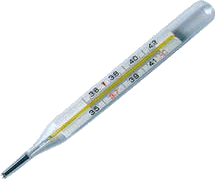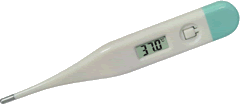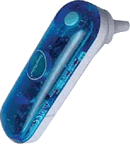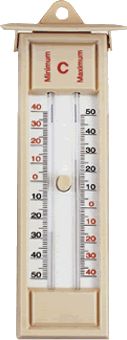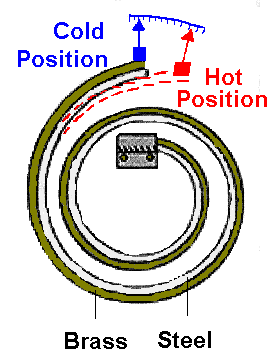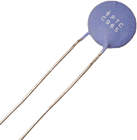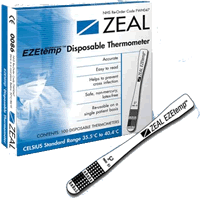Thermometers Click here for a diagram of a liquid in glass thermometer and the rules on using one
A Thermometer is an instrument that measures temperature. It can be used to measure the temperature of gases, liquids, and solids. It works by using the fact that certain measurable physical characteristics of substances change when the temperature changes e.g.
Types of thermometerA wide variety of devices are employed as thermometers. The main requirement is that one of the above easily measured properties should change markedly and predictably with changes in temperature. The variation of the property should change fairly linearly with changes in temperature. In other words, a unit change in temperature should lead to a unit change in the property to be measured at all points of the scale. There are many types of thermometers. They can be made as analogue or digital thermometers - ones that give a sliding scale reading as output or numeric output. They can be made to be used over and over again or as disposable thermometers. The first known thermometer was invented in 1593 by the Italian astronomer Galileo. It was called a thermoscope and was only fairly accurate. An truly accurate thermometer using alcohol was first developed in 1641. In 1714, Gabriel D. Fahrenheit, a German physicist, built a mercury thermometer of the type used today. Clinical (fever) thermometers.
Human body temperature is measured with a clinical, or fever, thermometer. In medical circles for many years a specialised type of liquid-in-glass thermometer was used that only measured temperature within a very limited range. This was filled with mercury and great care had to be taken when using it.
Many clinical thermometers today are designed to display the output in a digital format to make temperature reading easier.
Non-invasive (those that are not inserted in the body) and highly accurate infrared thermometers, called tympanic thermometers, have also been developed. They can take readings of body temperature by measuring heat coming from the ear. Liquid in glass thermometersLiquid-in-glass thermometers are the best-known type of thermometers. They are the ones you will use in the laboratory. You should know how to use one accurately. They can be used to determine the temperature inside a room or outside a building, to measure the body temperature, and in cooking. Mercury is the most common liquid in these thermometers. Alcohol is used in areas where the temperature frequently drops below the freezing point of mercury -39 °C or where mercury would be harmful if an accident occurred. A large volume of the liquid fills a glass bulb, which is connected to a sealed narrow glass tube. Some of the liquid partially fills this tube - but its volume is negligible compared to that in the bulb. The bulb is immersed in whatever it to have its temperature measured and absorbs or emits heat energy until it is the same temperature as the surroundings. When the temperature goes up, the volume of the liquid expands and the liquid rises and vice versa. An increase in temperature makes some of the liquid from the bulb rise up the tube, a decrease makes the liquid in the bulb contract and the liquid in the tube contracts back down into the bulb. The tube's thick, convex curved face acts as a magnifying lens that makes the thin thread of mercury clearly visible. A temperature scale is marked on the outside of the thermometer. The narrower the bore of the fine tube, the further apart the scale markings can be placed and the more accurately the temperature can be read. In making a liquid thermometer, the mercury is ordinarily driven to the top of the tube by heating. The glass is then sealed off, resulting in a vacuum when the mercury contracts during cooling. For high-temperature applications the tube is filled with a pressurized gas before sealing to prevent the mercury from boiling. For very high or very low temperatures, or for very accurate measurements, liquid-in-glass thermometers are not suitable. Various types of electrical thermometers are used instead. Maximum and Minimum Thermometers
Thermometers may also be designed to register the maximum or minimum temperature attained. A mercury-in-glass clinical thermometer, for example, is a maximum-reading instrument in which a trap in the capillary tube between the bulb and the bottom of the capillary permits the mercury to expand with increasing temperature, but prevents it from flowing back unless it is forced back by vigorous shaking. Maximum temperatures reached during the operation of tools and machines may also be estimated by special paint patches that change color when certain temperatures are reached and garden U-shaped thermometers allow the maximum and minimum temperatures reached in a greenhouse to be ascertained. Deformation-type thermometersThese change shape as a result of an increase or decrease in temperature. There are two main kinds of deformation thermometers: bimetallic and Bourdon tube. Bimetallic thermometers, the most common type, consist of two strips of different metals, such as iron and brass. The strips are fastened together from end to end, forming a composite bar. When the temperature rises, each metal expands a different amount, which causes the bar to bend . The greater expansion of brass compared to that of steel makes the brass curve round on the outside of the steel. This motion of the bar causes a pointer to move up or down a scale, indicating a temperature change. A thermograph includes a pen that makes a written record of temperature changes.
A bimetallic thermometer Bourdon tube thermometers have a curved, flexible metal tube filled with a liquid, such as glycerol or xylene. A rise in temperature makes the liquid expand. The tube straightens out to accommodate the increased volume of liquid. A pen or pointer attached to the end of the tube indicates the temperature. Electrical thermometers include thermocouples and resistance thermometers. Thermocouples, the most widely used type, consist of two wires, each of a different metal. Both ends of the two wires are twisted together to form junctions. One of these junctions, called the reference junction, is kept at a constant temperature— usually 0 °C. As the temperature of the other junction changes, a small voltage is generated between the two wires. The voltage is measured by a millivoltmeter. This can be calibrated to give a reading of the temperature. Most thermocouples that measure the temperature of the air have wires made of copper and an alloy called constantan. Thermocouples can be made with combinations of different wire to allow temperature measurement over a large range. They can be used to measure very high temperatures - up to 2800 °C. Resistance thermometers are made of metals like copper, nickel, or platinum. A temperature change causes a variation in the electrical resistance of these metals. (Resistance of a metal increases with temperature increase). They are used in a circuit and an ammeter can be calibrated to give a read-out in temperature. Scientists use platinum resistance thermometers to check the accuracy of all other types of thermometers. Extremely reliable platinum resistance thermometers are used to measure temperatures from -259.35 °C to 961.78 °C on the International Temperature Scale of 1990 (ITS-90). This scale provides a worldwide reference for temperature values.
With suitable circuitry, the current reading can be converted to a direct digital display of the temperature. Various thermistors made of oxides of nickel, manganese, or cobalt are used to sense temperatures between -46° and 150° C (between -50° and 300° F). Similarly, thermistors employing other metals or alloys are designed for use at higher temperatures; platinum, for example, can be used up to 930° C (1700° F). Thermistors and thermocouples can often have probes of less than 1cm in length, which alllows them to respond rapidly to temperature changes and also makes them ideal for many biological and engineering applications. The optical pyrometer can be used to measure temperatures of solid objects at temperatures above 700° C (about 1300° F), where most other thermometers would melt. At such high temperatures, solid objects radiate enough electromagnetic energy in the visual range (they glow!) to permit optical measurement. The color at which hot objects glow changes from dull red through yellow to nearly white at about 1300° C (about 2400° F). The pyrometer contains a light bulb type of filament controlled by a rheostat (dimmer switch) that is calibrated so that the temperature of the object can be compared to that of the bulb filament and the resistance of the filament can then be changed into a digital output of temperature. By viewing a very hot object - such as the interior of a furnace - through a pyrometer and by adjusting the filament until its color blends with that of the surroundings, the temperature of very hot surfaces can be estimated with fair accuracy Digital thermometers use electronic circuits and devices to communicate temperature measurements to the user. These thermometers display the measurements as numbers - using an LCD (liquid crystal display - like on your calculator) or LED (light emitting diode - little glowing segments) display. Digital thermometers measure the temperature of an appendage that is inserted into whatever you wish to find the temperature of. It is usually a slender device, remote from the circuitry called a probe. The probe is made of either a metal, such as copper or platinum, or a semiconductor. Temperature changes can cause a large variation in the electrical resistance of these materials. Most semiconductors are more sensitive to temperature changes than are metals. The probe is connected to an electronic circuit. The circuit receives temperature readings from the probe in the form of electrical signals. The signals are changed into numbers, which appear in a display window.
Disposable thermometers are sometimes used for measuring body temperature to avoid the passing of infection from patient to patient. They are cheaper than ordinary thermometers to manufacture and therefore to buy. Some disposable thermometers are made of materials that melt at certain temperatures. Others use substances called liquid crystals, which change appearance (colour) at specific temperatures. Accuracy of MeasurementAny thermometer indicates only its own temperature, which may not agree with the actual temperature of the object to be measured. In measuring the air temperature outside a building, for example, if one thermometer is placed in the shade and one in the sun, only a few centimeters away from each other, the readings on the two instruments may be quite different, even thoughthe air temperature is the same. The thermometer placed in the sun will absorb the sun's radiant heat. As a result, the indicated temperature may be significantly above the true air temperature. To avoid such errors, accurate temperature determinations require the shielding of the thermometer from hot/cold sources to or from which heat might be transferred by radiation, conduction, or convection. Accurate measurement of temperature depends on the 'establishment of thermal equilibrium between the thermometric device and its surroundings'. That means that the temperature of the thermometer must be exactly the same as the object it is meant to be measuring the temperature of. Transfer of heat energy between the object and the thermometer takes time.The thermometer must be allowed time to reach the temperature of what it is measuring. A clinical thermometer, therefore, must be inserted long enough (more than one minute) to reach near-equilibrium with the human body to yield an accurate reading. It should also be inserted deeply enough into, and have sufficient contact with the body, to indicate temperature accurately. These conditions are almost impossible to achieve with an oral (into the mouth) thermometer, which generally indicates a body temperature lower than that given by a rectal (into the anus) thermometer. Insertion times can be significantly reduced with small, rapidly reacting thermometers such as thermistor devices. If a thermometer is placed into a cold environment it will give out heat until it becomes the same temperature as its surroundings. If a thermometer is placed into a hot environment it will take inheat until it becomes the same temperature as its surroundings. Therfore the quantity of heat that is transferrred in this process should not be too large.... otherwise it will interfere too much with the temperature it is trying to measure and give a higher or lower reading because it has taken heat from (or given it to) the object and changed the temperature of the object it is measuring! Mercury is preferable in liquid in glass thermometers because it has a low specific heat capacity and therefore does not need to have much heat transferred to/from it when it changes temperature. Temperature scales.Gabriel Fahrenheit proposed the first widely adopted temperature scale, named after him, in which 32° F is the freezing point of water and 212° F is its boiling point at standard atmospheric pressure. Various temperature scales have been proposed since his time; in the centigrade, or Celsius, scale, devised by the Swedish astronomer Anders Celsius and used in most of the world, the freezing point is 0°C, the boiling point is 100°C The kelvin (named after Lord Kelvin) scale is used for scientific measurement. On this scale, water freezes at 273 K and boils at 373 K - note that there is no ° sign in front of the K! Some manufacturers produce thermometers with a temperature scale in Fahrenheit (especially in the USA). Most manufacturers produce thermometers with the Celsius scale. Scientific thermometers use the Kelvin scale. All temperature scales are now based on the International Temperature Scale of 1990. On this scale, temperature is determined by means of a series of fixed points called equilibrium states, which have assigned values. Temperatures are expressed in Celsius and kelvin units, but may be converted to other scales. See here |
Follow me...
|


